MXA’S 2015 KTM 450SXF MOTOCROSS TEST: VIOLIN VIRTUOSO
Q: FIRST AND FOREMOST, IS THE 2015 KTM 450SXF BETTER THAN THE 2014 450SXF?
A: Yes and no; it depends if we are talking about the production-based 2014 KTM 450SXF or the late-arriving 2014 KTM Factory Edition III (of which there were only 699 made). The differences between the production-based 2014 KTM 450SXF and the 2015 KTM 450SXF are fairly significant. However, since the 2014 450SXF Factory Edition III was the stalking horse of the 2015 production model, the differences between these two models are not extensive.
Q: WHAT DID KTM CHANGE FOR 2015?
A: For the majority of this test we will be referring to the 2014 production KTM 450SXF and will only be referencing the Factory Edition III when necessary. Here is a list of the changes between the 2015 model and the 2014 model.
(1) 4CS forks. Gone are the WP bladder forks of the past and in their place is the new 4CS fork. 4CS stands for “Four Chamber System,” and these new forks are only offered on American KTMs (Canada, Australia and the USA). The new fork is 6.5 ounces lighter than the old fork. The fork guards are now an open design and do not wrap around like previous KTM fork guards (and the old-style fork guards will not fit on the 4CS forks).
(2) Fork offset. The front axle offset has been changed at the fork lugs by moving the axle 2mm rearward (from 35mm in front of the fork center line to 33mm in front). This change required a switch from last year’s 25mm front axle to a smaller 20mm axle (saving 40 grams) to fit in the reduced space of the axle lug.
(3) Rear suspension. The rising rate has been changed via an all-new bell crank and 2.5mm-longer pull rod. The rising-rate curve is stiffer initially and then flattens out to provide a less progressive curve at the end of the stroke. To accommodate the longer linkage, the WP shock is 4mm longer. The suspension travel remains the same, but the seat height is lowered by 5mm at the rear fender.
(4) Frame cross tube. The cross tube that the shock linkage mounts to has been changed from a tube with welded-on brackets to a one-piece, forged cross tube for more rigidity.
(5) Frame color. The frame is now powdercoated orange to mimic the factory race bikes (and the Factory Edition III). If you want to paint your 2014 KTM frame orange, the correct powdercoat color code is RAL2009.
(6) Oil pump O-rings. The oil-pump suction screen gets new O-rings to help it seal better against impurities.
(7) Triple clamp. The black-anodized triple clamps remain unchanged, but it gets a new O-ring support for the bottom steering-stem bearing. The steering-stem bolt now has a 17mm hex head instead of the previous 27mm hex. Between the new steering-stem bolt and O-ring bearing support, the triple clamps are approximately 1 ounce lighter.
(8) Wheels. The suspect rims of the last four years have been replaced by what KTM promises are true-to-life black-anodized Excel rims. The spokes are black as are the Dunlop Geomax MX52 front and rear tires. We still recommend watching the spoke next to the rear rim lock closely.
(9) Grips. The dual-compound grips have a softer density for a more comfortable feel.
(10) Weight. Overall, the 2015 KTM 450SXF is a little over 1 pound lighter than the 2014 model (466 grams to be exact).
Q: HOW DO THE 4CS FORKS DIFFER FROM THE PREVIOUS WP BLADDER FORKS?
A: The 4CS forks differs in five major ways from the previous WP fork.
(1) The springs are on the top of the damping system and can be removed without having to take the fork completely apart.
(2) The oil height isn’t measured in cubic centimeters of oil, but instead by fork oil height (on a compressed fork with the spring out).
(3) All of the damping is housed in the lower fork-leg cartridge, where the piston on the end of the cartridge rod plunges through a sealed volume of oil, displacing it out of the inner cartridge into an outer cartridge, where it is bled off into a spring-loaded chamber that compensates for the rod’s volume.
(4) The compression adjuster is on the left fork cap, while the rebound clicker is on the right cap. Where the right and left fork legs differ is that the check valve on the end of the cartridge rod is reversed in each respective leg. That means that the right-side-up check valve can close free bleed during the compression stroke in the right fork leg, while the upside-down check valve in the left leg shuts off bleed during the rebound stroke. Other than the flip-flop, dual-duty, compression/rebound check valve, both forks legs are identical.
(5) Because the damping capabilities of the 4CS fork are much greater than on the WP bladder fork, the 2015 KTM 450SXF uses 0.48 Nm fork springs instead of the 0.50 Nm springs from the 2014 model.

Q: WHAT IS THE PRACTICAL DOWNSIDE TO THE 4CS FORK?
A: For racers who plan to send their 4CS forks out to have them re-valved, the information base is very shallow. Only 699 motocross versions of the 4CS forks had been produced prior to the releases of this bike. That means that your favorite suspension hop-up shop has very little experience with these forks. You and a guinea pig will have a lot in common until much later in the year.
Q: HOW GOOD ARE THE 2015 4CS FORKS?
A: At KTM there was an internal battle over the use of the 4CS forks on the American-bound bikes. WP wanted every bike to be equipped with the old-school bladder fork. KTM USA could see no marketing advantage in continuing to use a fork that the vast majority of American consumers do not like. So, KTM USA and WP respectfully agreed to disagree and the American branch set out on their own to fine-tune the 4CS fork for American consumers. To our way of thinking, this was a smart move KTM. Relying on WP’s expertise had proven to be a major disaster over the years. Going it alone was a brave move, but with risk comes reward.
So, how good are the 4CS forks? Every MXA test rider thought that the 4CS fork was superior in every way to the previous WP bladder fork and the overly firm 4CS fork on the 2014 Factory Edition III. But, that is if we only live in a WP universe. That the 4CS forks are better than the bladder forks does not make them better than Yamaha SSS suspension. The 2015 WP 4CS fork is much more absorbent than last year’s forks and has more effective damping. But they still tend to me harsh in the middle and slow or fast, every test rider turn the compression clicker out to try and make them more absorbent.

Q: HOW DOES THE 2015 KTM 450SXF HANDLE?
A: A few years ago the MXA wrecking crew recognized a major change in KTM handling. KTMs used to have flexy frames that felt like they had hinges in their middles. Then, suddenly, that changed. KTM’s chassis got stiffer, more accurate and well-mannered. Today, they have the best all-around-handling bikes on the track. Once you get the fore/aft balance dialed in, the KTM 450SXF does what you want to do with the least input of any modern motocross bike.
Although the RM-Z450 turns sharper, the KTM is the king of overall handling. It has a neutral chassis with very little oversteer and no understeer. We like it.
Q: WHAT ARE THE EFFECTS OF THE 2015 GEOMETRY CHANGES?
A: Historically, changes to KTM fork offset don’t seem to help or hinder the chassis in any big way. The MXA wrecking crew has tested offsets from 18mm to 22mm, and while each silly millimeter changed the character of the orange frame, none of them ruined its personality. As a rule, offset changes don’t seem to hurt the KTM’s basic handling package. Over the years KTM has gone from 14mm to 18mm to 20mm to 22mm offset without the word “wicked” ever coming into play. For 2015, KTM effectively returned to the 20mm clamps of three years ago (even though the triple-clamp offset remains at 22mm).
So how did KTM change the geometry, if they didn’t change the triple clamps offset? The front axle’s offset has been moved 2mm rearward (from 35mm in front of the fork center line to 33mm in front). This has the same effect as changing the offset at the triple clamps from 22mm to 20mm. By moving the front axle rearward, KTM’s engineers effectively increased trail, decreased wheelbase and moved the engine forward.
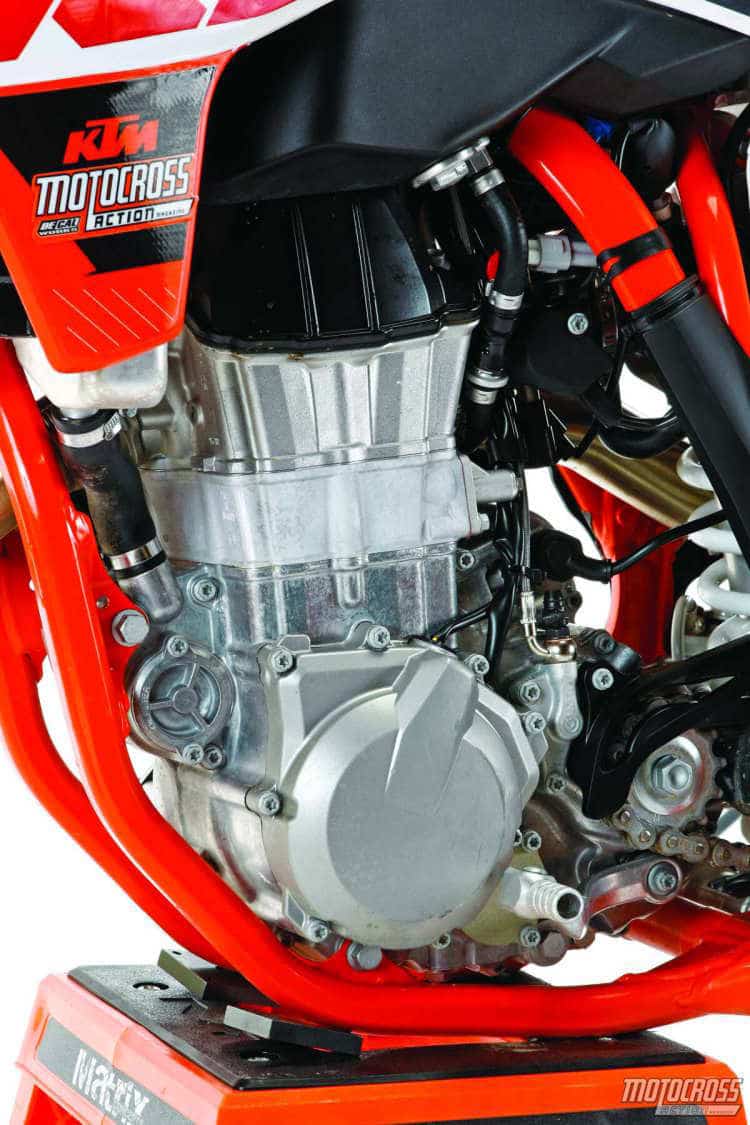
Q: WHAT DID KTM DO TO THE 2015 KTM 450SXF ENGINE?
A: If you don’t count the new oil ring on the oil-pump suction screen, then you are through counting. The 2015 450SXF engine is the 2014 engine.
Q: HOW FAST IS THE 2015 KTM 450SXF?
A: The KTM 450SXF runs like a runaway metronome. It starts out with a fairly pleasant rush of power. It goes tick, tock, tick, tock and, in musical terms, is largo. As the rpm climbs the tempo begins to pick up. It goes tickity, tickity, tickity, tock and the tempo becomes adagio. Then, in the meat of the midrange, the metronome flies off and the engine goes full-on prestissimo.
Although it isn’t a high-revving engine, it does pull across a broad range that is timed to perfection. Produces the most horsepower on any 2015 450 in the midrange. KTM has dialed in the exact kind of delivery that the typical KTM 450SXF owner needs. The powerband doesn’t have the brutal rush of the KX450F early or big horsepower numbers late like the YZ450F, but because of the way the power is delivered, it seems to pull twice as long as other 450s. This is the everyman 450 powerband.
Q: WHAT WOULD WE CHANGE IF WE RAN THE FACTORY?
A: Here is a list of what we’d do if we were the power elite at Mattighofen.
Fork damping. We have ridden aftermarket 4CS forks that are plush and forgiving — this tells us that the factory could od the same thing.
Shift lever. Move the tip up 5mm so that riders can get their boot under it. Shock preload ring. Metal, metal, metal. Not plastic.
Air filter cage. Give it a distinct shape that instinctively slips into place (with a notch to let you know it is secure).
Bar mounts. We have tried Ride Engineering triple clamps with rubber-mounted bars. Love them. We want them to come stock.
Steering-stem nut. We would drill a hole in it and route the gas-cap vent hose down through it.
Air boot. Why does every other KTM four-stroke have a velocity stack but the 450SXF doesn’t? We make our own Frankenstein version from a 350SXF and 450SXF boot. It would be nice if KTM did it at the factory.
Powerband. We want more grunt in the low-to-mid transition (without having to change exhaust pipes, gearing and make our own air boots).
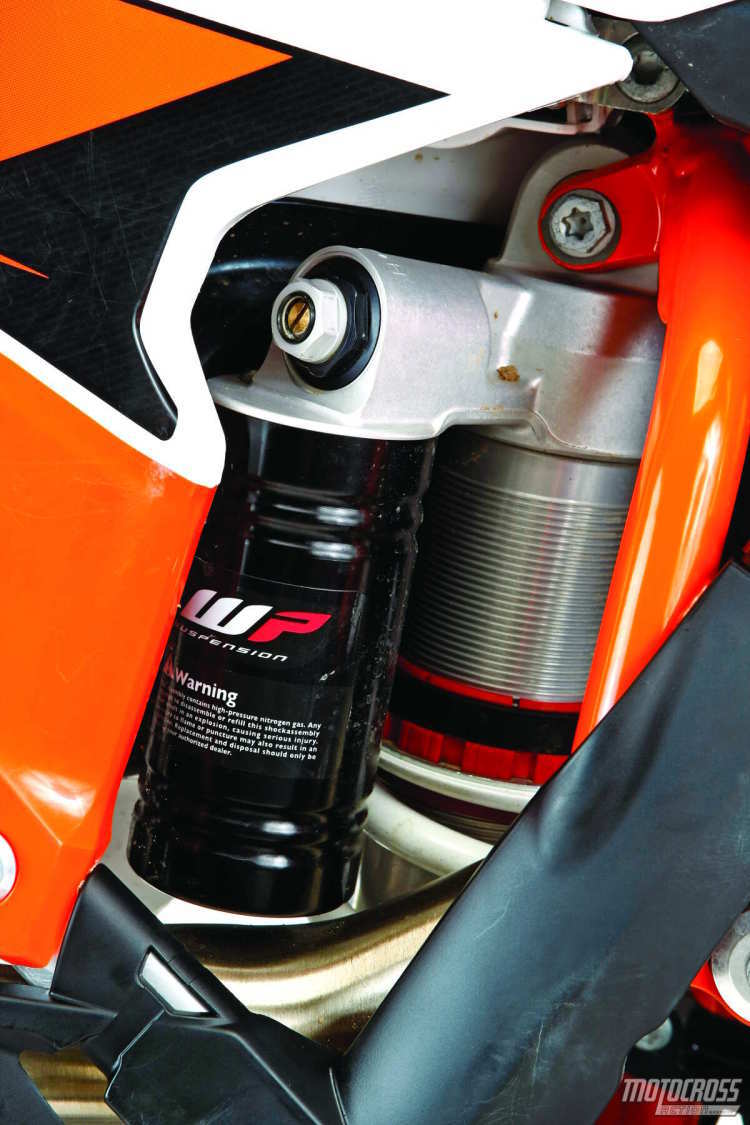
Q: WHAT DID WE HATE?
A: The hate list:
(1) Fork guards. We vastly prefer the old full-coverage fork guards. No, they aren’t as attractive or as light, but they extend fork-seal life by stopping rock dings caused by roost from the rear of the front wheel.
(2) Shift lever. When the shift lever is in the stock position it is too low, and when you move it up one notch, it is too high. MXA places their shift levers between two blocks on a hydraulic press and bows the middle of the shift lever to raise the tip.
(3) Air filter cage. Never stick the air filter into the airbox without double-checking to make sure that the filter’s back edge is sealed against the intake tract.
(4) Black frame guards. It’s kind of pointless to paint the frame orange and then install black plastic frame guards, especially when KTM has orange frame guards in stock.
Q: WHAT DID WE LIKE?
A: The like list:
(1) Weight. Oh, don’t get us wrong, it’s not a light motorcylce (only the CRF450 fits in that category). But, KTM did shave 1.3 pounds off of the 2015 model. If they did that every year it would be weightless in 220 years.
(2) Orange frame. You asked for it.
(3) Tires. The 450SXF is spec’ed with Dunlop’s new MX52 tire combo. This tire will replace the MX51 on the dealer shelves. And even though we typically run the MX32 on intermediate terrain, the hard-pack MX52 is a good OEM tire choice.
(4) Nylon preload ring. KTM knows that this is a mistake, but they are trying to pretend that it isn’t. At least they changed the nylon compound to help it take more abuse.
(5) 4CS forks. They aren’t perfect out of the box, but by WP standards they are a lot closer to perfection than what came before. we think that , if your aren’t bottoming, you should lower the oil height by 10cc (which is the equivalent of 10mm).
Q: WHAT DO WE REALLY THINK?
A: Did you notice that we never mentioned the electric starter, hydraulic clutch, powerful brakes, indestructible chain guide, no-tools airbox, FIM-legal sound rating, SKF fork seals, quick-release fuel lines, resilient chromoly frame, CNC-billet bell crank, in-mold graphics, marine-grade wiring harness, inline fuel filters, or CNC-machined polished hubs? If we had, this test would have read like a love note to the Austrians. Well, in a way it is.

MXA KTM 450SXF SETUP SPECS
This is how we set our KTM 450SXF up for racing. We offer it as a guide to help you find your own sweet spot.
4CS FORK SETTINGS
Unlike the previous WP bladder fork, the clickers on the 4CS forks actually make a difference. This enabled the MXA test riders to make small clicker adjustments that made noticeable differences on the racetrack. Overall, we went out on the compression. Since the oil height and fork springs can be changed with half the drama of the bladder forks, we think the 4CS has lots of tuning potential. For hardcore racing, we recommend this fork setup on the 2015 KTM 450SXF (stock specs are in parentheses):
Spring rate: 0.48 Nm
Oil height: We lower the oil height by 10cc. The stock setting is suppose to be 100mm, but our tets bike shad a nigher, thus stiffer, oil height.
Compression: 17 clicks out (15 clicks)
Rebound: 9 clicks out (15 clicks)
Fork leg height: 5mm up
Notes: Balance between the front and rear suspension is the key to happiness on the 450SXF. If the shock and fork are out of sync, one end will be adversely effected and not necessarily the end that is set up wrong. It pays big dividends to take the time to test different fork heights.
WP SHOCK SETTINGS
The new shock is 4mm longer than before, but the rear-wheel travel doesn’t change, because the new shock linkage allows the shock to hang lower. The rear suspension feels more supple than last year’s setup, but every test rider complained about the tendency for the shock to G-out, especially when sitting down on the exit of rutted corners. We ironed this out with more high-speed compression damping. For hardcore racing, we recommend this shock setup for the 2015 KTM 450SXF (stock specs are in parentheses):
Spring rate: 5.7 kg/mm
Race sag: 103mm
Hi-compression: 1-3/4 turns out (2 turns out)
Lo-compression: 15 clicks out
Rebound: 10 clicks out (15 out)
Notes: As a rule of thumb, most MXA test riders stayed near the standard settings, except on rebound (which we slowed down). The spring rate on our bike was questionable. we had G-out issues, which we traced to the new white shock spring. Although listed as a 5.7 Nm spring, it tested out as a 5.62 Nm spring. When we checked our 2014 springs, which was orange, it tested out at 5.76. For heavier or faster riders, the 2014 orange spring should prove to be stiffer than the 2015 white spring.


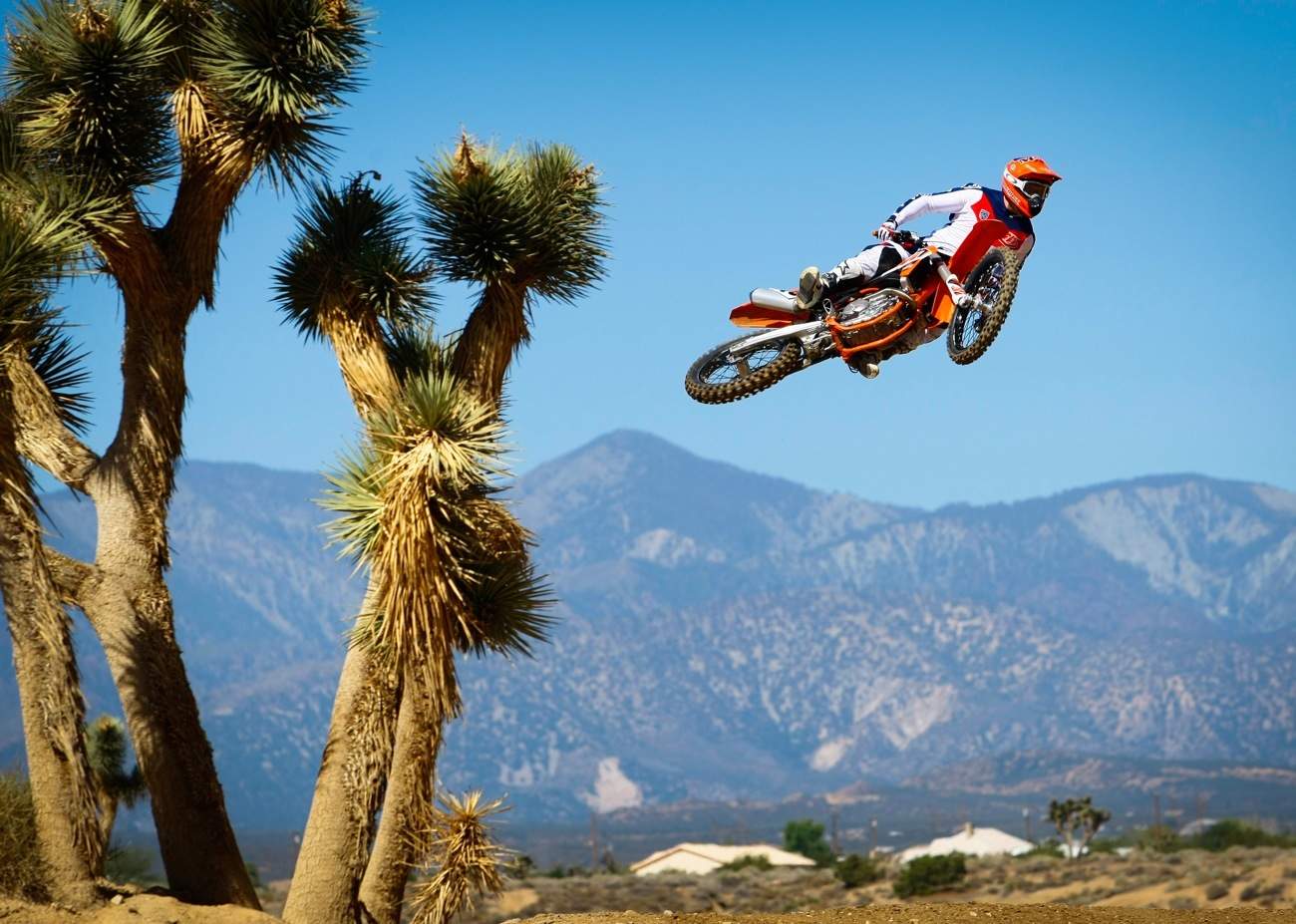
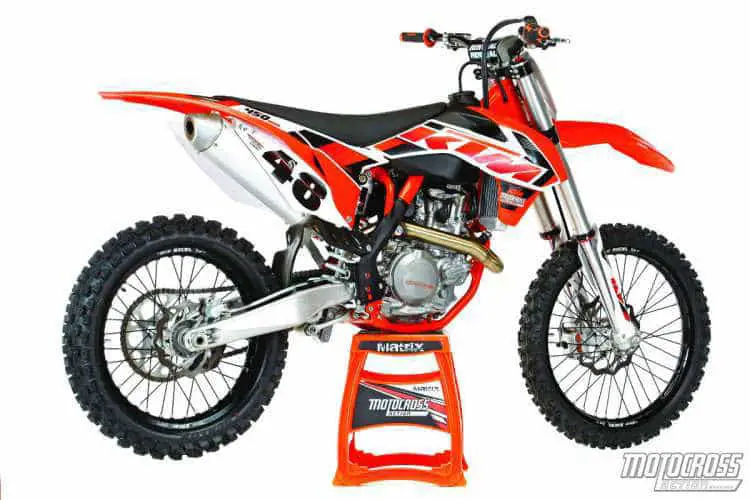
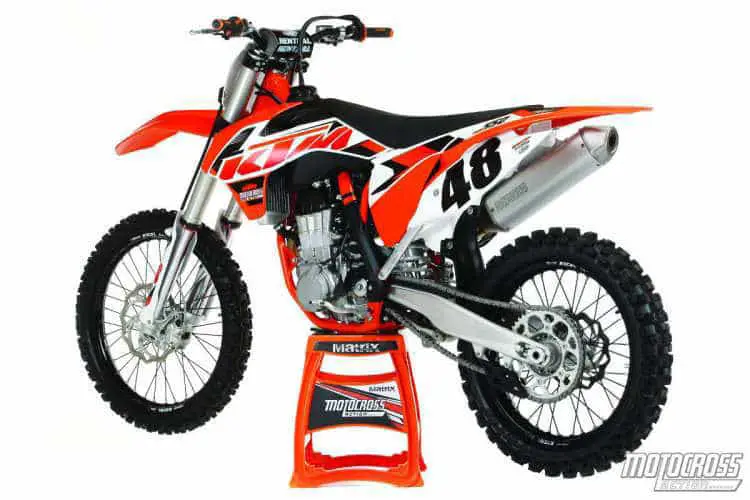




Comments are closed.